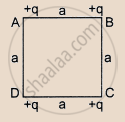Advertisements
Advertisements
Question
Write any two important points of similarities and differences each between Coulomb's law for the electrostatic field and Biot-Savart's law of the magnetic field ?
Solution
Following are the similarities between Coloumb's law for the electrostatic field and Biot-Savart's law of the magnetic field:
(i) Both the laws obey superposition principle.
(ii) In both the laws, the field at any point varies inversely to the square of distance from source to the point of observation. Hence, both the laws are long range.
Following are the differences between Coloumb's law for the electrostatic field and Biot-Savart's law for the magnetic field:
| Coloumb's Law for Electrostatic Field | Biot-Savart's Law for Magnetic Field |
| 1. The electrostatic field is produced by the electric charge, q, which is a scalar quantity. | The magnetic field is produced by the current element,
|
| 2. The electrostatic force acts along the line joining the source and the point, which is the displacement vector. | The magnetic field acts perpendicular to the plane containing current element
\[I {dl}^\rightharpoonup\] and displacement vector \[r^\rightharpoonup\] which is along the direction of \[(I {dl}^\rightharpoonup \times r^\rightharpoonup )\].
|
APPEARS IN
RELATED QUESTIONS
NaCl molecule is bound due to the electric force between the sodium and the chlorine ions when one electron of sodium is transferred to chlorine. Taking the separation between the ions to be 2.75 × 10−8 cm, find the force of attraction between them. State the assumptions (if any) that you have made.
Suppose an attractive nuclear force acts between two protons which may be written as F=Ce−kr/r2. Suppose that k = 1 fermi−1 and that the repulsive electric force between the protons is just balanced by the attractive nuclear force when the separation is 5 fermi. Find the value of C.
Two particles A and B possessing charges of +2.00 × 10−6 C and of −4.00 × 10−6 C, respectively, are held fixed at a separation of 20.0 cm. Locate the points (s) on the line AB, where (a) the electric field is zero (b) the electric potential is zero.
Two identical particles, each with a charge of 2.0 × 10−4 C and mass of 10 g, are kept at a separation of 10 cm and then released. What would be the speed of the particles when the separation becomes large?
Answer the following question.
What is relative permittivity?
A force F acts between sodium and chlorine ions of salt (sodium chloride) when put 1 cm apart in air. The permittivity of air and dielectric constant of water are `epsilon_0` and K respectively. When a piece of salt is put in water, electrical force acting between sodium and chlorine ions 1 cm apart is ____________.
A total charge Q is broken in two parts Q1 and Q2 and they are placed at a distance R from each other. The maximum force of repulsion between them will occur, when ____________.
SI unit of permittivity of free space is ______.
Four equal charges q are placed at the four comers A, B, C, D of a square of length a. The magnitude of the force on the charge at B will be ______.

